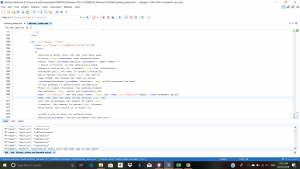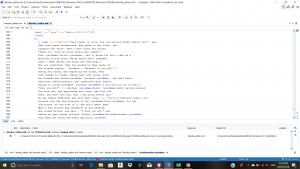The past couple of weeks, my group and I have been doing a lot to try and transcribe the memoir of Elizabeth Grundy. I am in a group of four and we each were assigned to 6 pages each. It was very challenging being able to read the tough cursive. Having to read it so many times, I realized how tough Elizabeth Grundy’s life was. She went through very much struggle and had to react in different circumstances. She also looked to God very much, asking for his help. Each group member was assigned a certain amount of pages of the memoir, so that aspect was individual, but we eventually needed to come together to create the timelines and when we started tagging everything. We had to discuss and decide which words were tagged to which specific thing. One debate we had was whether Jesus, Savior, and Christ were going to be marked as “Persname” or “Rolename”. This was important because people have different beliefs, and we all needed to agree on the tag. We decided on “Rolename” so then we had to make sure everyone tagged those. Another thing that we had trouble with was deciding what was considered “objects” and what we’re not. I originally did not know if every noun or thing was an object. We decided on only specific words being objects. It took a while to tag each emotion and to decide the words. Here is an example of the decision to tag God as roleName instead of persName. It was an important decision to choose this and it worked out well for our group.
![]()
In the reading “A Rationale of Digital Documentary Editions” by Elena Pierazzo, the author states how she believes that a transcription is a form of translation. Each transcription is translated differently so each author creates different transcriptions. There are many different features included in the process that help the transcription. The author chooses their specific interpretation and they chose what to represent each and it changes based on the author’s vision. There are purposes of editors, which are similar to what we do with tagging. We also edit by making sure the words match the same as the original document.
Here is an example of the different tags for each emotion. It took a lot to find each and to physically tag each word.
![]()
Caroline Walsh is a sophomore at Bucknell University and is from Needham, Massachusetts. She has two sisters, including an identical twin, who also attend Bucknell. Caroline is a member of the women’s lacrosse team on campus and enjoys hanging out with her friends.

 The process of collaborating as an editorial board with my group also changed my understanding of how edited texts are produced. When collaborating with my group one had to keep in mind in we needed to do as a whole. “Decisions about what one should encode and should not encode are to be determined according the purpose of our encoding.” (469) The meaning I took from this is that as a collective group we needed to come to an understanding in what we encode in the transcription. As I said before each human as a different idea in what word means to them. A personal example can be the word “emotion.” “Can “emotion” have emotion?” was the question I had to my group. When talking about it, we tried resolve the issue by trying to understand the context in when the word was used and then we will have a majority vote in what it was. Also, we had help from other people in class in what they thought in our project. As Elena speaks, “From the editors’ interpretation of the text and of the author(s) intentions it is necessary now to consider the readers of the edition and ask what must be added to the edition itself to satisfy their needs and expectations. ” Having the the opinions that are not from our group is essential to have because even as a group we can mistakes as a whole in our Transcription.
The process of collaborating as an editorial board with my group also changed my understanding of how edited texts are produced. When collaborating with my group one had to keep in mind in we needed to do as a whole. “Decisions about what one should encode and should not encode are to be determined according the purpose of our encoding.” (469) The meaning I took from this is that as a collective group we needed to come to an understanding in what we encode in the transcription. As I said before each human as a different idea in what word means to them. A personal example can be the word “emotion.” “Can “emotion” have emotion?” was the question I had to my group. When talking about it, we tried resolve the issue by trying to understand the context in when the word was used and then we will have a majority vote in what it was. Also, we had help from other people in class in what they thought in our project. As Elena speaks, “From the editors’ interpretation of the text and of the author(s) intentions it is necessary now to consider the readers of the edition and ask what must be added to the edition itself to satisfy their needs and expectations. ” Having the the opinions that are not from our group is essential to have because even as a group we can mistakes as a whole in our Transcription.